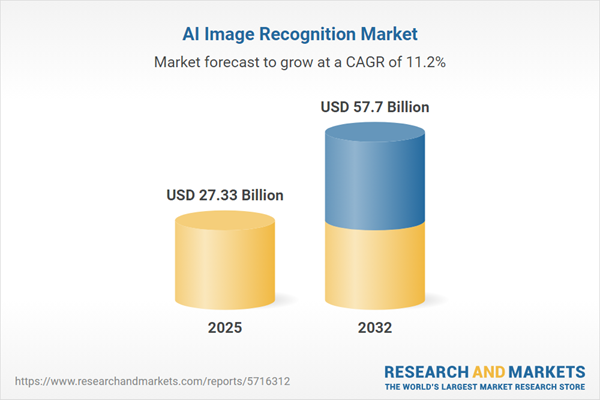Speak directly to the analyst to clarify any post sales queries you may have.
The AI image recognition market is evolving rapidly, driven by advancements in deep learning, new deployment models, and expanding use across major industries. Senior executives are increasingly leveraging AI-based visual intelligence to transform processes, optimize operations, and unlock new value streams in an era of digital acceleration.
Market Snapshot: AI Image Recognition Market Growth and Opportunity
The AI image recognition market grew from USD 24.72 billion in 2024 to USD 27.33 billion in 2025 and is projected to reach USD 57.70 billion by 2032, advancing at a CAGR of 11.17%. This momentum reflects the sector’s increasing ability to support operational transformation across healthcare, industry, security, and retail environments, making image recognition an essential driver of modern business models.
Scope & Segmentation
- Component: Hardware (cameras, processors, sensors), Services (consulting, deployment, integration), and Software (analytics tools, image processing, machine learning algorithms).
- Technology: Includes code recognition, facial recognition, object recognition, optical character recognition, and pattern recognition.
- Application: Covers use in augmented reality, image search, marketing and advertising, scanning and imaging, and security and surveillance.
- End User Industry: Automotive, banking & financial services, entertainment & media, healthcare, manufacturing, and retail are key verticals adopting these solutions.
- Deployment Mode: Supports both cloud-based and on-premise architectures.
- Geography: Analysis covers North and Latin America (United States, Canada, Mexico, Brazil, Argentina, Chile, Colombia, Peru), Europe (UK, Germany, France, Russia, Italy, Spain, Netherlands, Sweden, Poland, Switzerland), Middle East (UAE, Saudi Arabia, Qatar, Turkey, Israel), Africa (South Africa, Nigeria, Egypt, Kenya), and Asia-Pacific (China, India, Japan, Australia, South Korea, Indonesia, Thailand, Malaysia, Singapore, Taiwan).
- Companies Reviewed: Includes industry leaders and innovators such as Airy3D Inc., Amazon Web Services, Inc., Anthropic PBC, Clarifai, Inc., DataRobot, Inc., Google LLC, Intel Corporation, Microsoft Corporation, Nvidia Corporation, Oracle Corporation, Panasonic Holdings, QualComm Technologies, Snap2Insight, Toshiba Corporation, Trax Technology Solutions, and others.
Key Takeaways: Strategic Insights for Decision Makers
- AI image recognition solutions now deliver visual classification accuracy approaching human levels, enabling mission-critical use across healthcare, finance, and manufacturing.
- Modern architectures, such as edge computing, support real-time processing and reduce latency, responding to advanced industry needs for speed and privacy in visual analytics.
- The democratization of AI frameworks and APIs accelerates experimentation, adoption, and scaling within organizations, including pilot programs and enterprise production environments.
- Sector convergence and robust partnerships between semiconductor, software, and integration providers are critical in delivering turnkey solutions that streamline implementation and interoperability.
- Organizations are increasingly investing in talent acquisition, upskilling, and strategic collaborations to maximize returns from AI image recognition and align solutions with business objectives.
- Capabilities such as automated quality inspection, customer authentication, and visual content tagging are no longer pilot programs but have transitioned into critical enterprise functions.
Tariff Impact: Navigating Global Policy Shifts
Recent U.S. tariff adjustments have created new challenges in sourcing technology components essential to the image recognition value chain. Increased duties on sensors, processors, and optical modules have driven higher costs, compelling industry stakeholders to explore regional sourcing and localized manufacturing. Larger enterprises have been more able to adapt, while smaller firms experience constraints in hardware access. These shifts have extended procurement cycles, increased the focus on strategic supply chain management, and impacted total cost of ownership for AI-driven image recognition systems.
Methodology & Data Sources
This report is based on a rigorous methodology that combines secondary research—including journals, white papers, regulatory data, and proprietary databases—with direct inputs from industry executives and domain experts. Structured interviews and expert panels validate the trends and insights, while data triangulation ensures robust conclusions.
Why This Report Matters
- Offers a clear lens into the fast-changing landscape of AI image recognition, empowering senior leaders to align investments and strategies with technology and market realities.
- Provides actionable segmentation, regional, and vendor analyses for more confident procurement and go-to-market decisions.
- Highlights competitive positioning and strategic imperatives essential for mitigating supply chain risk and maximizing the impact of AI in visual business intelligence.
Conclusion
AI image recognition is reshaping operational landscapes as organizations prioritize visual intelligence for efficiency, innovation, and future growth. This report gives decision makers the framework to capitalize on technological advances and manage emerging complexities in the global market.
Additional Product Information:
- Purchase of this report includes 1 year online access with quarterly updates.
- This report can be updated on request. Please contact our Customer Experience team using the Ask a Question widget on our website.
Table of Contents
3. Executive Summary
4. Market Overview
7. Cumulative Impact of Artificial Intelligence 2025
Companies Mentioned
The companies profiled in this AI Image Recognition market report include:- Airy3D Inc.
- Amazon Web Services, Inc.
- Anthropic PBC
- Blippar Group Limited
- Clarifai, Inc.
- Cognitec Systems
- DataRobot, Inc.
- Delaware corporation
- Fritz Labs Inc.
- Google LLC by Alphabet Inc.
- Honeywell International Inc.
- Huawei Cloud Computing Technologies Co., Ltd.
- Infrrd Inc.
- Intel Corporation
- International Business Machines Corporation
- iProov Ltd
- MERCURIO PLATFORM, S.L.
- Microsoft Corporation
- Monolith AI Ltd.
- NEC Corporation
- Nvidia Corporation
- Oracle Corporation
- Panasonic Holdings Co., Ltd.
- Qualcomm Technologies, Inc.
- Snap2Insight Inc.
- Standard Cognition, Corp
- Toshiba Corporation
- Trax Technology Solutions Pte Ltd.
- Vispera Information Technologies
- Ximilar s.r.o.
Table Information
| Report Attribute | Details |
|---|---|
| No. of Pages | 197 |
| Published | November 2025 |
| Forecast Period | 2025 - 2032 |
| Estimated Market Value ( USD | $ 27.33 Billion |
| Forecasted Market Value ( USD | $ 57.7 Billion |
| Compound Annual Growth Rate | 11.1% |
| Regions Covered | Global |
| No. of Companies Mentioned | 31 |









